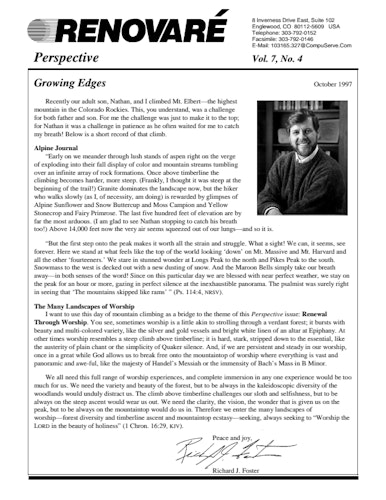From the Renovaré Newsletter Archive
The selection below is from a October 1997 Renovaré newsletter.
Download a PDF of the original newsletter.
In the late 90s my adult son, Nathan, and I climbed Mt. Elbert — the highest mountain in the Colorado Rockies. This, you understand, was a challenge for both father and son. For me the challenge was just to make it to the top; for Nathan it was a challenge in patience as he often waited for me to catch my breath! Below is a short record of that climb.
Alpine Journal
Early on we meander through lush stands of aspen right on the verge of exploding into their fall display of color and mountain streams tumbling over an infinite array of rock formations. Once above timberline the climbing becomes harder, more steep. (Frankly, I thought it was steep at the beginning of the trail!) Granite dominates the landscape now, but the hiker who walks slowly (as I, of necessity, am doing) is rewarded by glimpses of Alpine Sunflower and Snow Buttercup and Moss Campion and Yellow Stonecrop and Fairy Primrose. The last five hundred feet of elevation are by far the most arduous. (I am glad to see Nathan stopping to catch his breath too!) Above 14,000 feet now the very air seems squeezed out of our lungs — and so it is.
But the first step onto the peak makes it worth all the strain and struggle. What a sight! We can, it seems, see forever. Here we stand at what feels like the top of the world looking “down” on Mt. Massive and Mt. Harvard and all the other “fourteeners.” We stare in stunned wonder at Longs Peak to the north and Pikes Peak to the south. Snowmass to the west is decked out with a new dusting of snow. And the Maroon Bells simply take our breath away — in both senses of the word! Since on this particular day we are blessed with near perfect weather, we stay on the peak for an hour or more, gazing in perfect silence at the inexhaustible panorama. The psalmist was surely right in seeing that “The mountains skipped like rams” (Ps. 114:4, NRSV).
The Many Landscapes of Worship
I want to use this day of mountain climbing as a bridge to my theme: Renewal Through Worship. You see, sometimes worship is a little akin to strolling through a verdant forest; it bursts with beauty and multicolored variety, like the silver and gold vessels and bright white linen of an altar at Epiphany. At other times worship resembles a steep climb above timberline; it is hard, stark, stripped down to the essential, like the austerity of plain chant or the simplicity of Quaker silence. And, if we are persistent and steady in our worship, once in a great while God allows us to break free onto the mountaintop of worship where everything is vast and panoramic and awe-ful, like the majesty of Handel’s Messiah or the immensity of Bach’s Mass in B Minor.
We all need this full range of worship experiences, and complete immersion in any one experience would be too much for us. We need the variety and beauty of the forest, but to be always in the kaleidoscopic diversity of the woodlands would unduly distract us. The climb above timberline challenges our sloth and selfishness, but to be always on the steep ascent would wear us out. We need the clarity, the vision, the wonder that is given us on the peak, but to be always on the mountaintop would do us in. Therefore we enter the many landscapes of worship — forest diversity and timberline ascent and mountaintop ecstasy — seeking, always seeking to “Worship the Lord in the beauty of holiness” (1 Chron. 16:29, KJV).
Growing Together
Worship is critical to exercising ourselves unto Godliness. Below are a few simple exercises that are designed to help you explore this important Discipline of the Spiritual Life.
Learn to practice the presence of God daily.
With Brother Lawrence, let us sense the presence of God with as great a reality when “washing pots and pans” as when receiving the holy Eucharist. We can follow Paul’s words, “Pray without ceasing,” by punctuating every moment with inward whisperings of adoration, praise, and thanksgiving. We can schedule personal times of inner worship and confession and attentiveness to Christ, our present Teacher. Doing this heightens our expectancy in public worship, because the gathered experience becomes a continuation and intensification of what we have been trying to do all week long.
Have many different experiences of worship.
Personally, individually we can learn to worship God. Little home groups can meet not just for Bible study, but for the very experience of worship itself. Gather little groups of two and three and learn to wait upon God, learn the experience of prayer. Many things can happen in smaller gatherings that cannot happen in a larger group because of sheer size. If possible, visit church traditions other than your own and experience the different approaches to worship: their strengths and weaknesses. All of these experiences of worship will empower and enkindle the Sunday gatherings in your home church.
Find ways to prepare for the gathered experience of worship.
You may want to prepare for Sunday worship: by going to bed early on Saturday night; by having an experience of examination and confession; by going over hymns and Scriptures that will be used on Sunday; by gathering before the worship service begins to pray that God’s presence will fill the room; by letting go of inward distractions so that you can be genuinely present.
Be willing to be gathered in the power of the Lord.
Learn to let go of your personal agenda, of individual concerns, of a special need to be blessed, of hearing the word of God. The language of the gathered fellowship is not “I” but “we.” There is submission to the ways of God. There is submission to one another in the Christian fellowship. There is submission for the good of everybody. There is a desire for God’s life to rise up in the group, not just the individual. If I pray for spiritual gifts, they are made manifest not just to me but to any person in the group or upon the group as a whole if that would please God. We become of one mind, of one accord. We are gathered.
Cultivate a holy dependency, a holy expectancy, and a holy obedience.
In worship, a holy dependency says that we are utterly and completely dependent upon God’s touch for anything significant to happen. There is inward travail and inward struggle that we might be truly dependent, that the evil will weaken, that the good will rise up. Within the group, a holy expectancy looks forward to God moving and acting and teaching and wooing and winning. For everyone, a holy obedience is a determination to do whatever Christ tells us to do. If he urges us to speak or to teach or to give a witness or a prophetic message, we are obedient. If we are to make confession, if we are to respond to what is happening, we do exactly what he says with a holy obedience that has been cultivated by years of experience.
Absorb distractions with gratitude.
If there is noise or distraction, take it in and conquer it rather than fussing or fuming. If little children are running about, bless them. Thank God that they are alive and that they have energy. Maybe they’re a message from the Lord. When I’m preaching, I love to have little babies and children in the congregation because sometimes they are the only ones that appear alive! Become willing to relax with distractions. Learn to receive whatever happens in gathered worship as an experience from God instead of feeling that the service has to follow your agenda or that distractions somehow deter you from worshiping God.
Learn to offer a sacrifice of worship.
Many times we don’t “feel” like worshiping. Maybe we have had so many disappointing experiences in the past where the sense of God’s power is so low that we think it is hardly worth the time. People are not adequately prepared, and it is very, very discouraging. But we need to go anyway. We need to offer a sacrifice of worship. We need to be with the people of God and say, “These are my people. As stiff-necked and hardhearted and sinful as they may be, I stand with them and together we come to God.” The Bible tells us not to forsake the assembling of ourselves together, and it does that because we are the Body of Christ together.
Resources for Renewal
With a theme like Renewal Through Worship, there are books galore. But I want to narrow the field down for you and at the same time give you a solid foundation upon which to think about worship, and to enter into a deeper, richer, fuller worship experience. Here are six resources:
A Brief History of Christian Worship by James F. White. White is the undisputed authority in Christian liturgical history with fifteen books in the field. This book is a jewel in its brevity and sweep of history from the early Christian centuries through the Middle Ages and the Reformation up to the present. It even has a brief statement on “Worship in the Churches of the Future.”
Prayer and Worship by Douglas V. Steere. This tender little book is a wonderful antidote for what Steere calls “the pressure and temporarily satisfying narcotic of intense busyness.” Indeed, the book is worth those startling sentences that seem to jump out of the text, e.g. “In the school of adoration the soul learns why the approach to every other goal had left it restless.”
Reaching Out Without Dumbing Down by Marva J. Dawn. This is the most substantive of the new books which is trying to guide us through our “worship war” over “traditional” versus “contemporary” expressions of worship. Dawn takes both theology and culture seriously which is what makes this book so helpful. I especially like her stress on the role of worship in character formation — e.g. consider her chapter title on preaching, “Worship Ought to Kill Us: The Word.”
The New Worship by Barry Liesch. Liesch is a professor of music and this is reflected in the music emphasis of his book. It is exceedingly practical and will give you many solid handles for framing your practice of worship. The book has a supplemental computer disk dealing with keyboard modulation and improvisation.
Worship by Evelyn Underhill. For a theology of worship this book really sets the standard among Protestants, and everyone measures their understanding of worship off of it. Her discussion of “ritual and symbol, sacrament and sacrifice” is worth the price of the book.
First published in Perspective, October 1997.
Photo by Dave Hoefler on Unsplash
Text First Published October 1997 · Last Featured on Renovare.org January 2022
Get spiritual formation articles like this each Friday
Renovaré Weekly is our thoughtful free newsletter with curated articles, books, and upcoming free webinars.

Richard J. Foster is the innovative pioneer who reintroduced ancient spiritual resources to contemporary Christians, especially among evangelicals and other Protestants. The author of several bestselling books, including Celebration of Discipline and Streams of Living Water, he is the founder of Renovaré, an infrachurch movement committed to the renewal of the Church in all her multifaceted expressions. Having studied at George Fox University and Fuller Theological Seminary, Foster has served as a pastor and taught worldwide on spiritual formation. He and his wife, Carolynn, have two grown children, many grandchildren, and live near Denver, Colorado.



